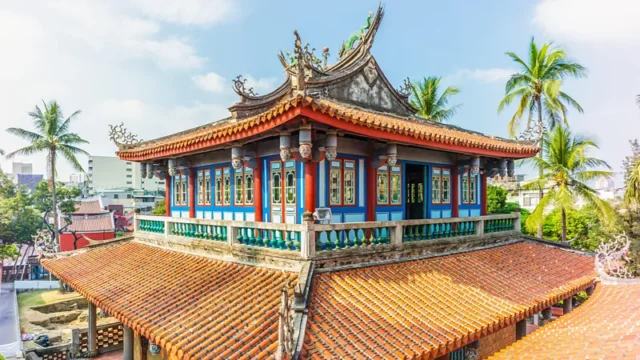Introduction: Tainan 400th anniversary
Tainan, the oldest city in Taiwan, is celebrating its 400th anniversary by highlighting its rich, multicultural past. Known as “the birthplace of Taiwan,” this city offers a unique glimpse into the island’s diverse history and cultural evolution.
The Dutch Arrival and the Birth of Tainan
Establishing Fort Zeelandia
In 1624, the Dutch East India Company arrived on an island off the coast of China, seeking a trading foothold with the Ming dynasty after failing to seize Macau. They established a base on a sandbank and built Fort Zeelandia, calling the settlement Tayouan – later known as Taiwan.

Early Interactions with the Siraya People
The Dutch traded with the local Siraya people, who spoke an Austronesian language related to Malay, Tagalog, and Māori. Some scholars suggest that the name “Taiwan” derives from the Siraya word “tavo-an,” meaning “meeting-place.”
Celebrating 400 Years of Tainan
Tainan 400 Festivities
This year marks the 400th anniversary of Fort Zeelandia and the city of Tainan. The Tainan 400 celebrations began in January with the Taiwan Lantern Festival and will continue throughout the year. The festivities, under the slogan “Tainan, Where You Belong,” include concerts, exhibitions, and public events showcasing the city’s cultural diversity.
Exploring Tainan’s Cultural Heritage
A City Where Past and Present Collide
Tainan is a city where the past and present coexist harmoniously. Unlike the skyscrapers of Taipei or Kaohsiung, Tainan preserves its historical roots with ancient monuments and narrow streets lined with centuries-old buildings. The city is also home to numerous Buddhist and Taoist temples, adding to its cultural richness.

Fort Zeelandia and Kaitai Tianhou Temple
Fort Zeelandia, located in Tainan’s Anping district, is a popular tourist attraction where visitors can explore the ruins entwined with banyan roots. Nearby, the Kaitai Tianhou temple, dedicated to the sea goddess Mazu, dates back to 1668 and is the oldest shrine to the island’s most popular deity.
Tainan’s Culinary Delights
Tainan is renowned as Taiwan’s street food capital. Local delicacies like shrimp crackers, fried sweet potato balls, and “coffin bread” (fried bread stuffed with seafood sauce) reflect the city’s vibrant food culture. The streets are filled with vendors selling these treats, enhancing the city’s lively atmosphere.
Tainan’s Diverse Linguistic Heritage
Indigenous Roots and Early Education in Tainan 400th anniversary
Before the Dutch arrived, Taiwan was home to various Indigenous groups. The Dutch established the island’s first school in Tainan in 1636, teaching in Siraya. In 1661, Ming dynasty rebel Koxinga expelled the Dutch, leading to waves of migration from China, primarily Hokkien-speaking settlers from Fujian.
Qing Dynasty and Hakka Influence
When Taiwan became part of the Qing dynasty, Tainan became the capital of Taiwan Prefecture. This period saw the arrival of Hakka-speaking communities, adding to the island’s linguistic diversity. Taiwan remained under Qing control until it was ceded to Japan in 1895.
Japanese Era and Language Shift
Under Japanese rule, Japanese became the island’s lingua franca. Many elderly Taiwanese still prefer speaking Japanese over Mandarin. The period from 1949 onwards saw the Nationalists enforcing Mandarin as the national language, overshadowing Taiwan’s diverse linguistic heritage.
Rediscovering Multicultural Identity Tainan 400th anniversary
Post-Martial Law Cultural Revival
Since the end of martial law in 1987, Taiwan has been rediscovering its multicultural identity. Tainan has been at the forefront of this movement, embracing its linguistic diversity. The Tainan 400 website greets visitors in Taiwanese, Siraya, and Hakka, reflecting the city’s commitment to cultural inclusivity.

Efforts to Revive Taiwanese Language
Efforts to revive the Taiwanese language are ongoing. Dr. Tsio̍h Bo̍k-bîn, head of the Confucius temple’s cultural foundation, emphasizes the importance of linguistic diversity. He believes that promoting Taiwanese, Hakka, and Indigenous languages is crucial for a linguistically equal society.
Language Revival Initiatives
Popularizing Taiwanese Language in Tainan 400th anniversary
YouTuber Chiu Ka-éng, known as Ayo, is one of the figures promoting the Taiwanese language. Her channel, Tâi-lâm muē-á kàu lí kóng Tâi-gí (A Tainan Girl Teaches You Taiwanese), combines high-energy delivery with linguistic research to make learning Taiwanese engaging.
Reawakening the Siraya Language
The revival of the Siraya language is spearheaded by Uma Talavan and her husband Edgar Macapli. Their efforts have led to Siraya being taught in over 20 schools across Tainan. Talavan hopes that Siraya will be used from kindergarten through university in the future.
Embracing Tainan’s Complex Tapestry
A City of Multiple Roots
Spending time in Tainan reveals its complex tapestry of languages and cultures. The Tainan 400 celebrations remind us that identity is multifaceted and that there is strength in embracing this complexity.
Proud of Hybrid Heritage
As Dr. Tsio̍h Bo̍k-bîn asserts, Taiwan is a hybrid society with a rich history of cultural blending. Recognizing and celebrating this hybridity is key to understanding Taiwan’s unique identity and fostering peace within its diverse society.
Conclusion: Tainan 400th anniversary
Tainan, with its rich cultural heritage and commitment to linguistic diversity, offers a unique glimpse into Taiwan’s history. The Tainan 400 celebrations not only honor the city’s past but also pave the way for a future where multiple languages and cultures are cherished. By exploring Tainan, visitors can immerse themselves in a vibrant, multicultural experience that reflects the true essence of Taiwan.











